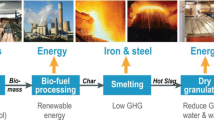Abstract
The biomass usage in the steel industry has benefits not only due to its “CO2 neutral carbon”, but also due to its unique chemical and physic-chemical properties. This contribution focuses on two aspects which could increase the economic efficiency of this technology. The first one is related to the thermal treatment of biomass. Woody biomass wastes were pyrolysed in a laboratory scale screw continuous reactor at different temperature profiles. Besides solid product (charcoal), yields of organic liquid and a gaseous products consisting of carbon oxides, light hydrocarbons and hydrogen were considered. The share and quality of these three fractions can be controlled by the pyrolysis parameters such as temperature, heating rate, residence time as well as presence of catalysts.
The second aspect is related to the optimisation of grain size of injected solids. Different grain size fractions in the range from about 0.1 to 1.8 mm were prepared and tested using a laboratory injection rig. Furthermore, microstructure of charcoal samples were examined. Results were compared with a reference pulverised coal. It was concluded that coarser grinding of charcoal than that for coal can be sufficient for its conversion in the blast furnace raceway. The microstructure of charcoals may have a great influence on their conversion behaviour along with the chemistry. The effect of injection rate on conversion rate depends on grain size of charcoal.
Zusammenfassung
Der Einsatz von Biomasse in der Stahlindustrie ist nicht nur aufgrund ihres „CO2-neutralen Kohlenstoffs“ vorteilhaft, sondern auch wegen ihrer einzigartigen physikalischen und chemischen Eigenschaften. Dieser Beitrag befasst sich mit zwei Aspekten, welche die Wirtschaftlichkeit des o. g. Prozesses verbessern können: thermische Aufbereitung von Biomasse und Optimierung der Korngröße des festen Produktes.
Zum ersten Punkt wurden Abfälle der holzartigen Biomasse in einem kontinuierlich fördernden Schneckenreaktor mit Pyrolyse- und Gasaufbereitungskammer bei verschiedenen Temperaturprofilen pyrolysiert. Der Anteil an drei gewonnenen Fraktionen – die Feststoffphase Holzkohle, eine flüssige, aus Wasser und aromatischen Verbindungen bestehende Phase und eine Gasphase – kann durch Pyrolyseparameter, wie Temperatur, Verweilzeit, Aufheizrate sowie Katalysatoren gesteuert werden.
Zum zweiten Punkt wurden die Holzkohleproben mit unterschiedlichem Kornband von 0,1 bis 1,8 mm auf ihre Umsetzung in einer Laboreinblasanlage untersucht. Weiterhin wurde die Mikrostruktur der Holzkohle untersucht. Der Vergleich mit Einblaskohle zeigte, dass das gröbere Mahlen von Holzkohle eine ausreichende Umsetzung in der Wirbelzone gewährleisten kann.




Similar content being viewed by others
References
Babich, A.; Senk, D.; Gudenau, H. W.: Ironmaking, Düsseldorf: Verlag Stahleisen, 2016
Vassilev, S. V.; Baxter, D.. Andersen, L. K.; Vassileva, C. G.: An overview of the chemical composition of biomass, Fuel., 89 (2010), pp 913–933
Suopajärvi, H.; Kemppainen, A.; Haapakangas, J.; Fabritius, T.: Extensive review of the opportunities to use biomass-based fuels in iron and steelmaking processes, J. Clean. Prod., 148 (2017), pp 709–734
Mathieson, J. G.; Rogers, H.; Somerville, M.A.; Ridgeway, P.; Jahanshahi, S.: Use of biomass in the iron and steel industry—An Australian perspective, Proceedings, 1st Int. Conf. Energy Effic. CO2 Reduct. Steel Ind. (EECR Steel 2011), pp 1–10. Proc. METEC InSteelCon® 2011, 1st International Conference on Energy Efficiency and CO2 Reduction in the Steel Industry (EECRSteel), 27.06.–01.07.2011, Düsseldorf, Germany, 2011
Babich, A.; Senk. D.: Biomass use in the steel industry: back to the future?, stahl und eisen, 133 (2013), No 5, pp 57–67
Mathieson, J. G.; Somerville, M. A.; Deev, A.; Jahanshahi, S.: Utilization of biomass as an alternative fuel in ironmaking, Iron Ore Mineral. Process. Environ. Sustain., Elsevier Ltd., 2015, pp 581–613
Wei, R.; Zhang, L.; Cang, D.; Li, J.;. Li, X.; Xu, C. C.: Current status and potential of biomass utilization in ferrous metallurgical industry, Renew. Sustain. Energy Rev., 68 (2017), pp 511–524
Andronov, V. N; Babich, A. I.; Yaroshevskii, S. L; Ivanov, A. I.; Pakhomov, I. A.; O.K. Anufriev, O. K.; Yang Nai-fu: Size grinding of coal dust for blast furnaces, Steel USSR—Engl. Translation, 18 (1988), No 5, pp 197–199
Rudak, R.: Einblasen von Kohl mit Zuschlagstoffen in den Hochofen, Dr.-Ing. Thesis, Aachen: RWTH Aachen, 1994
Chen, W. H.; Du, S. W.; Yang, T. H.: Volatile release and particle formation characteristics of injected pulverized coal in blast furnaces, Energy Convers. Manag., 48 (2007), pp 2025–2033
Yu, D.; Xu, M. Sui, J.; Liu, X.; Yu, Y.; Cao, Q.: Effect of coal particle size on the proximate composition and combustion properties, Thermochim. Acta., 439 (2005), pp 103–109
Solar, J.; de Marco, I.; Caballero, B. M.; Lopez-Urionabarrenechea, A.; Rodriguez, N.; Agirre, I.; Adrados, A.: Influence of temperature and residence time in the pyrolysis of woody biomass waste in a continuous screw reactor, Biomass and Bioenergy, 95 (2016), pp 416–423.
Senk, D.; Babich, A.: Eisenmetallurgie. Eisenreduktion und Schachtöfen, Stahleisen GmbH, 2013
Basu, P.: Introduction in Biomass Gasification Pyrolysis Pract. Des. Theory, 1st ed., Oxford: Elsevier, 2010, pp 1–25
Author information
Authors and Affiliations
Corresponding author
Additional information
Publisher’s Note
Springer Nature remains neutral with regard to jurisdictional claims in published maps and institutional affiliations.
Rights and permissions
About this article
Cite this article
Hippe, F., Babich, A., Senk, D. et al. Efficiency of Biomass Pyrolysis Product Injection into the Blast Furnace. Berg Huettenmaenn Monatsh 164, 261–266 (2019). https://doi.org/10.1007/s00501-019-0826-0
Received:
Accepted:
Published:
Issue Date:
DOI: https://doi.org/10.1007/s00501-019-0826-0




